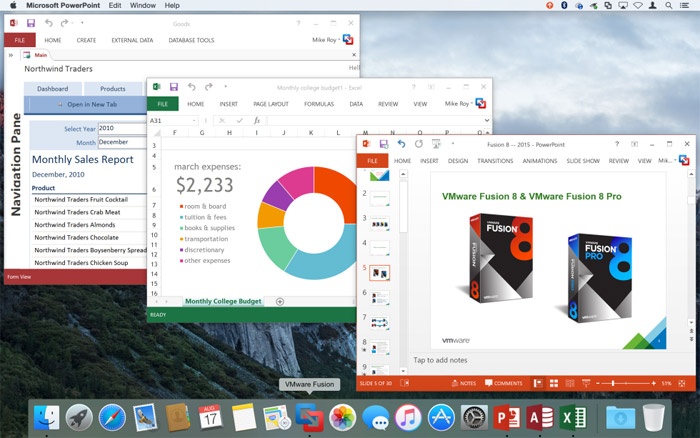

Also, if your VMWare Tools installer certificate has expired, set the system date prior to Octo(thanks to Jesse for the update).)Ĭlick Virtual Machine > Install VMWare Tools > Install > double click Install VMWare Tools > Continue > Continue > Install > enter password > OK > Continue Installation > before clicking Restart, restore ist: sudo mv ~/Desktop/ist /System/Library/CoreServices/istĬlick Apple menu > Software Update… > install the single update that appears ( iLife Support 9.0.4)Ĭhecking for updates again returns: "Your software is up to date.
Vmware fusion 8 mac os x#
VMWare Tools requires Mac OS X version 10.5 or higher." error. Quit Terminal, install Snow Leopard, and boot to Desktopīefore installing VMWare Tools, move ist somewhere (e.g., Desktop): sudo mv /System/Library/CoreServices/ist ~/Desktop/ist (Otherwise you will receive a "VMWare Tools can’t be installed on this disk. Make necessary directories and file: mkdir -p /Volumes/Macintosh\ HD/System/Library/CoreServices/ & touch /Volumes/Macintosh\ HD/System/Library/CoreServices/ist Start SnowLeopard virtual machine > click desired language and press Return > Utilities > Terminal Right click SnowLeopard in list of virtual machines > Show in Finder > right click SnowLeopard.vmwarevm > Show Package Contents > add the following line to SnowLeopard.vmx (to mask the CPU since new CPUs are not supported by versions prior to 10.6.7): cpuid.1.eax = "0000:0000:0000:0001:0000:0110:1010:0101" VMWare Fusion 8 > File > New… > "Create a custom virtual machine" (dragging in the DMG misidentifies it as OS X 10.5) > Continue > Apple OS X > Mac OS X Server 10.6 > Continue > Create a new virtual disk > Continue > Customize Settings > assign filename (e.g., SnowLeopard) > Save > CD/DVD (SATA) > Choose a disc or disc image… > select SLserver.dmg > adjust CPU, RAM, hard disk size as desired while you’re in settings > close 10.6 window Write the changes to a new image (e.g., SLserver.dmg): hdiutil convert -format UDRO -o ~/Desktop/SLserver.dmg ~/Desktop/SL.dmg -shadow Insert Snow Leopard retail DVD (OS X 10.6.3) > Disk Utility > highlight the DVD drive ( not the "Mac OS X Install DVD" volume) > File > New Image > Image from "Untitled" > select read/write format (though, according to VMWare, any format should work) > assign desired filename (e.g., SL.dmg) and location (e.g., Desktop) > SaveĬreate a shadow file: hdiutil attach ~/Desktop/SL.dmg -shadowĬopy ist to ist: cp /Volumes/Mac\ OS\ X\ Install\ DVD/System/Library/CoreServices/ist /Volumes/Mac\ OS\ X\ Install\ DVD/System/Library/CoreServices/istĮject the volume: hdiutil eject /Volumes/Mac\ OS\ X\ Install\ DVD/ See below for a discussion of OS X 10.6's EULA.

usr/bin/sudo /bin/rm -rf /Applications/VMware \ Fusion.Installing Snow Leopard into VMWare Fusion 8 on El Capitan / docs / Installing Snow Leopard into VMWare Fusion 8 on El Capitan # the rest must be run as an "admin user" or "root" bin/rm -rf ~/Library/Preferences/.lockfile bin/rm -rf ~/Library/Preferences/.plist.lockfile bin/rm -rf ~/Library/Preferences/VMware \ Fusion bin/rm -rf ~/Library/Application \ Support/VMware \ Fusion # osascript -e 'delay 3' -e 'tell Application "Dock"' -e 'quit' -e 'end tell' -e 'delay 3' usr/libexec/PlistBuddy -c "Delete persistent-apps:$ " ~/Library/Preferences/

I= " $(defaults read persistent-apps | grep bundle-identifier | awk '// ' ) " # Note: Uninstalling Fusion does not affect the contents of a virtual machine. # uninstall script for VMWare Fusion, per VMware knowledge base


 0 kommentar(er)
0 kommentar(er)
